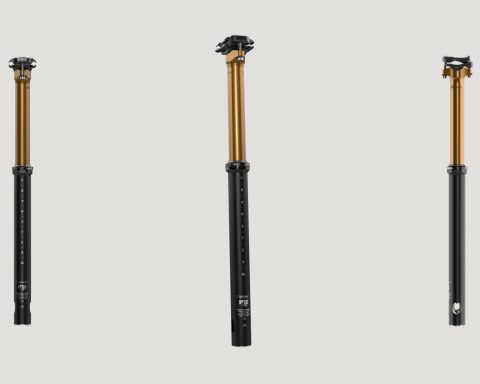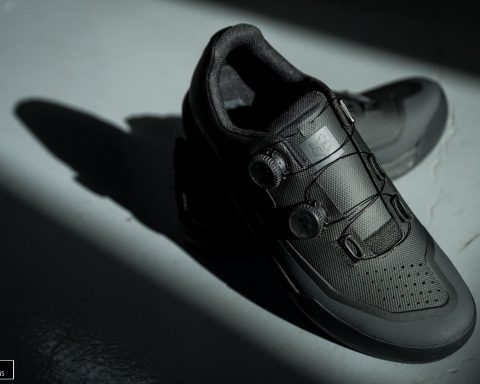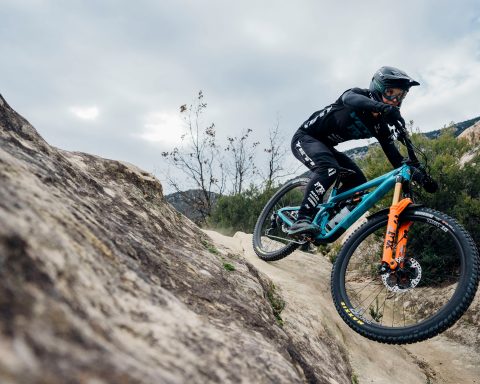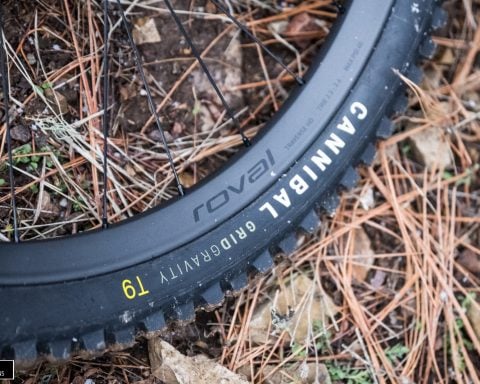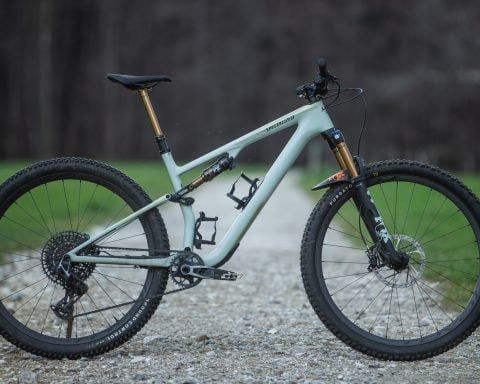After close to a year’s time spent aboard the newly updated MY25 Fox 38, it’s time to publish our full review. This fork takes shape as a mid-model update, rather than a full chassis overhaul. Although the limited edition gold colorway might steal the show in an aesthetic sense, the main update is the new Grip X2 damper. While a great deal of this review will center around on the new damper, for the purpose of being thorough we’ll still cover the entirety of the fork’s performance for those unfamiliar with the Fox 38 in general. Read on for the full scoop…
Details
- 27.5″ and 29″
- 160mm, 170mm (tested) and 180mm travel options
- $1,249.00 USD
- 38mm stanchions
- Tool free air bleeders with air channels
- Externally adjustable high and low speed compression and rebound
- 180mm direct post mount brake
- Bolt on floating axle
- 2,194 grams claimed weight / 2,383 grams actual (our scale, 7.5″ steerer, no volume reducers, 29″ X 170mm)
The big story here is the new Grip X2 damper, so that seems like a good place to start. For a primer on what’s different, you can check out this video , but in short, many aspects of it have literally gotten bigger in size. This includes not only the mid valve and the base valve but also the damper’s body itself. It’s worth quickly noting that this comes with a nominal weight penalty. Anyhow, these changes increase support and improve tunability. Regarding the latter, the number of detents (read: clicks) on the high compression side increased a bit and the dial has a longer gaps between each click. More on Grip X2 further down…
Fox uses their floating axle with a 6mm pinch bolt, which helps to keep the dropouts aligned properly and thus decreases bushing/seal wear by preventing side loading.
The high and low speed rebound clickers remain externally adjustable and unchanged. They’re knurled for plenty of grip and are protected by a threaded cap. Much like the last 38, the low speed clickers for both rebound and compression are slightly vague and can be a little difficult to count, particularly if there is background noise.
Given that the chassis hasn’t changed, the air bleeders remain as well as the air channels, which increase the volume of the trapped air in the lower legs, which in turn helps to diminish the effect the trapped air has on the fork’s ride characteristics. Personally I’m quite fond of the bleeders as I live at ~2,000 feet but my lift assisted laps start at ~6,200 feet, so being able to easily neutralize the trapped air helps me get a consistent feel at my local bike park.
Lastly, Fox offers a short and long (shown installed, above) fender. Both are very tough and I’m a big fan of how they attach. While it’s a little annoying having to use a 13mm socket to remove the bleeders and install them, they are very secure and won’t scuff the paint in your lower legs.
Grip X2
Below is a side by side of new Grip X2 (left) and Grip2 (right, sans compression adjustment knobs). The Grip X2 now has an oversized 24mm base valve with 23 shims whereas the Grip2 damper had a 20mm base valve with just 7 shims. This allows for a broader range of adjustability and increased control over the damping. That the entire architecture of the new damper is larger in general allows for lower damper pressures and thus improved performance, which in turn lets riders run lower air spring pressures.
Setup
On the air side I started out around the 86 psi mark, which was slightly lower than where I left off on the previous 170mm travel 29″ 38 that I had ridden. Interestingly, due to the improved support from the damping side I also was able to use either one or zero volume reducers, whereas on Grip2 I usually ran two volume reducers. When it came to getting the hydraulic side dialed in I started with the recommended settings then experimented a bit until I found the sweet spot…
On the trail
In crude and simple terms my initial impression of the updated damper was that it felt like it moves more oil in a better and more controlled fashion. Thus, true to Fox’s claim, I could rely less on the air spring side to achieve the ride dynamic I was looking for as I was able to lean on the damping side a bit more. As we touched on earlier this meant I was running slightly lower air pressure, one to two less volume reducers and more damping – particularly on high speed compression. On the Grip2 damper my HSC was one click from full open and I didn’t really utilize the adjustment as I found things got a bit spiky rather quickly. Whereas on Grip X2 I found myself closer to the middle of the range and fine tuned by a click or two in either direction based on the riding conditions. This can and should be interpreted as a greatly improved *usable* range in adjustment. To put a finer point on things it’s fair to say that I was able to get away with a more linear setup, which was advantageous in rougher terrain – particularly in the mid stroke. This improvement was felt first and foremost in my hands being less fatigued, but also in the form of increased confidence on rougher terrain and at higher speeds.
One aspect I noticed was that initially the fork felt a little bit less lively and seemed very glued to the ground – particularly on small to mid sized bumps. This ties in logically to leaning more on the damping side of things and although I can’t remember exactly where I was on the prior generation with regard to low speed rebound clicks, I did find myself speeding that adjustment up slightly to provide me with a little bit more pop when I needed to get the bike off the ground to offset that feeling. It’s worth noting that that didn’t come at the expense of comfort or traction, so it’s a marked improvement to be sure. While I could certainly be accused of being overly sensitive to bike related noise, another positive aspect I noticed was that the new damper is substantially quieter. I’d even go so far as to say it’s the quietest fork that I’ve ridden to date in this category.
Moving forward, we’ll touch on some of the baked in features and aspects that are unchanged with the Fox 38 but very much worth going over. Aside from issues with creaky crown/steerer/upper leg assemblies a few years ago I think the body which houses all the guts of this fork is pretty close to perfect – especially in terms of stiffness and handling – so why mess with a good thing? That applies both to torsional stiffness in the corners as well as fore/aft stiffness under heavy braking – the 38 is excellent in both aspects. While I have personally never had bushing issues with any of the 38s I’ve owned or tested over the years, I was informed that Fox did quietly improve the lower bushings on the MY25+ models. Other strong points for this chassis are the bleeders, the floating axle, plus the excellent fenders and their means of attachment.
One aspect that I had initially thought of as a slightly low point is that Fox forgoes a 200mm direct mount brake for a 180mm option. The downside of this is that it’s slightly less simple, given that most riders will need some form of brake adapter. However, Martin Maes’ recent win in Loudenville aboard a 180mm front rotor sparked some chatter on this topic and it’s worth chewing on for a bit. Another argument for a 180mm front rotor option is the forthcoming Magura Gustav Pro, which will feature 2.5mm thick rotors and unprecedented stopping power. So perhaps Fox was on to something all along…? After all, smaller rotors do also have better ground clearance.
If I had to lodge one minor complaint against the 38 it’s that the bottom out bumper is sub par. At least in my opinion anyway. However, I would also say the same thing about the last version as well as this fork’s main competitor, the RockShox ZEB, so it isn’t as if the 38 is an outlier in this regard. I want the option to set up my fork with a fairly linear feel, but not have to worry about wrist jarring bottom outs when things get a bit out of control. It’s worth noting that those harsh bottom outs are pretty rare for me, but the point still stands. Basically I want to have my cake and eat it too, and thus I dream of a day when non-boutique mountain bike forks have hydraulic bottom outs – or at the very least, larger bottom out bumpers that are tapered and/or captured.
Overall
All in all I’ve been extremely impressed with this fork and would put it at the very top of my list as the market currently stands. As far as value is concerned, if the price is a bit steep for you, consider the Performance Elite version of this fork which saves you about $100 solely by dropping the cool but not totally necessary Kashima coating. If you’re currently happy with your Fox 38 but want to give it a refresh, another option is a Grip X2 damper upgrade. Further more, if you’re pondering that route and don’t need quite as many adjustments the 3-way Grip X damper is a great option as well, plus it features a solid lockout at full close. In any case I think it’s safe to say that the 38 remains the benchmark fork in the Enduro category and at the end of the day there is little, if anything, to really pick apart. Hats off to Fox on a nice mid-model update.














